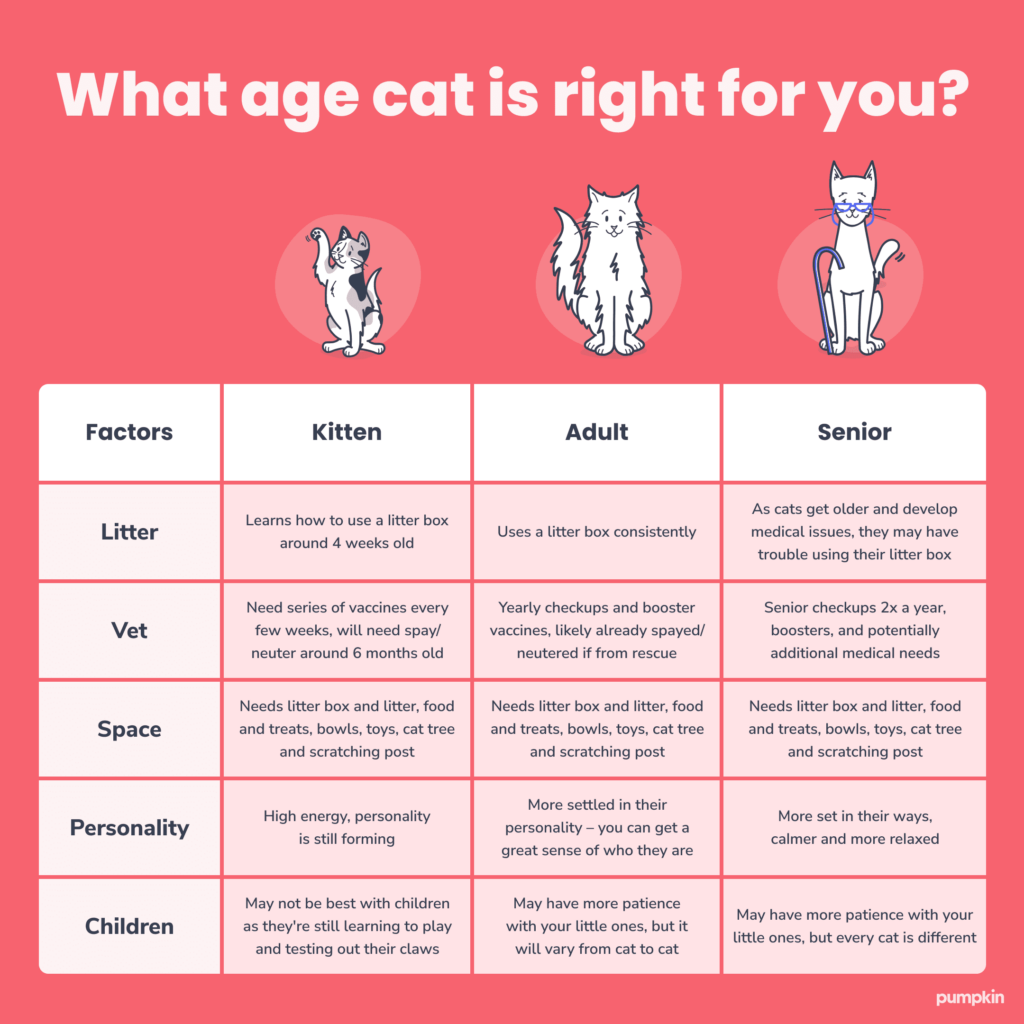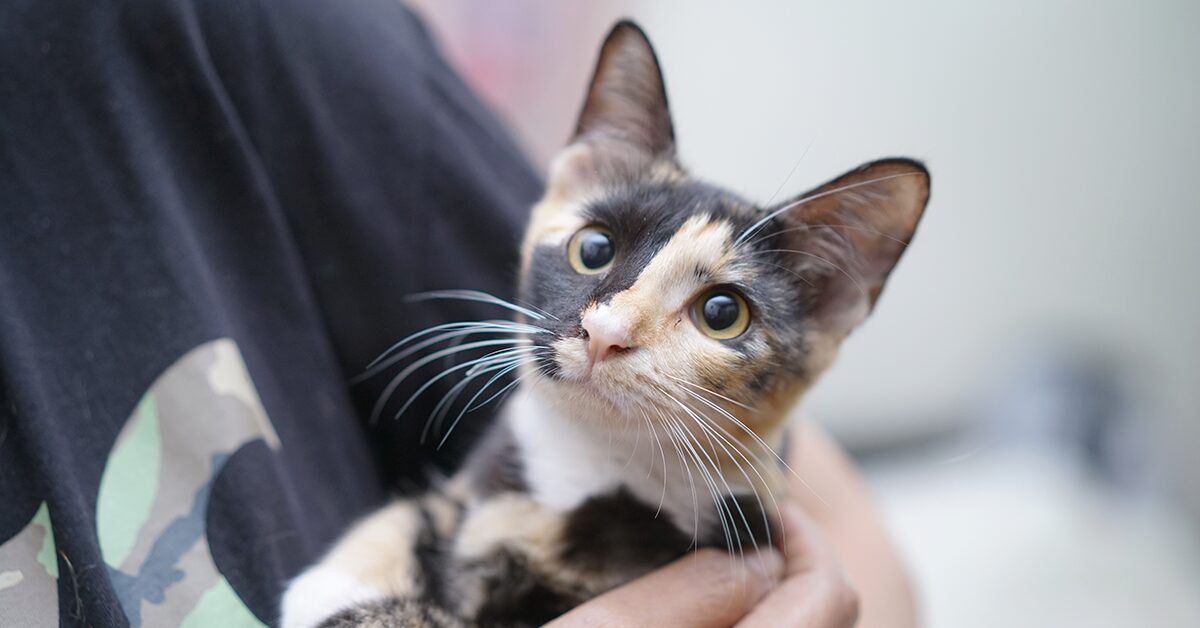Adopting a cat is a big decision that comes with a lot of responsibility, but it’s all worth it for a little whiskered friend! From cuddles to playtime, there are many pleasures that come with being a cat owner.
But before you buy your cat food and cat toys, make sure you do your homework. Wherever you’re planning to adopt from, there are a few things you must know.
What’s the best age to adopt a cat?
One of the first decisions you have to make is between adopting a new kitten and an older cat. Much will depend on your situation and the environment into which you’re bringing your new pet. Kittens are adorable, and their high energy makes them entertaining – but young cats and young children don’t always mix well, so keep this in mind if you have a young family.
Older cats have a calmer temperament. However, they may also face more health issues, depending on their age. It’s worth noting, however, that with an older cat, you won’t have to face some of the difficulties that come with raising kids and raising kittens at the same time.
Tip: Thankfully, litter training isn’t one of those difficulties, as most kittens have an instinctive knowledge that they need to go in the litter box and bury their poop. Some senior cats can have more of a problem with this, particularly when they start to develop health problems.
This decision will also depend on your lifestyle and the space you’re offering your new pet. If you live in a small apartment, an older cat with less need to bound and play, may be better – although, with cat condos and other feline-optimized furnishings, even a small space can become a wonderland for cats of all ages.
Tip: If you are going to let your cat roam outside, it’s a good idea to implant a microchip.
An increasingly common trend, sparked by social media, is to adopt “special needs cats,” particularly ones with dwarfism or a developmental disorder that makes them seem cuter or kitten-like. There’s nothing wrong with this (it may be a much-needed corrective since special needs cats have often been less likely to be adopted) so long as you’re willing and able to provide the extra care this cat will need. Remember: adopting a cat isn’t buying a new accessory. It’s taking on responsibility for a living thing, and pledging to care for them.

Health considerations you need to know before adopting a cat
Cats, like humans, need to go to the vet regularly to stay healthy, so finding a veterinarian before adopting a cat can help ensure your kitty is protected from day one. Be prepared for regular checkups and preventive care to make sure your feline friend is still in tip-tail shape.
Alongside an initial exam, there are a number of essential vaccines your cat should receive early in life to prevent diseases like rabies and feline leukemia. If you’re adopting an older cat, they may already have received these vaccines or the shelter or rescue may have done this already.
It’s also extremely important to spay or neuter your cat. Per the American Humane Society, all domestic cats should be spayed or neutered in order to prevent the development of feral cat communities, which can pose a hazard to local wildlife populations. There are varying opinions amongst vets about the age at which cats should be spayed or neutered, but the common consensus is around six months of age. Again, some shelters may have done this before adoption, but if not, consult with a veterinarian as soon as possible.
You probably know this by now, but it bears repeating: declawing is a cruel procedure that should never be performed on a cat. Trim your cat’s nails regularly or cover them in “claw caps” to make sure they don’t cause harm, but avoid unnecessary surgeries that will only hurt your cat.
The application process
Most shelters require you to fill out an application before agreeing to let you adopt. This application is usually fairly straightforward in its requirements. The purpose is to make sure that you’re responsible enough to take care of your cat, and have the resources to do so.
One of the questions you’ll be asked is whether you rent or own your home. Cats need a stable and comfortable environment, and if you’re constantly moving from one place to another, your cat will feel lost and unhappy. Making sure your home environment is safe is another priority for shelters. In some cases they may even send a representative to your home to make sure it’s safe.
The application process may also include requests for references who can speak to your character and personal responsibility. If you’ve ever taken care of someone else’s pet or pets, they will probably be a great resource. The application may also ask you to list a veterinarian – this is another reason to begin a relationship with a vet before adopting a cat.
Introducing your cat to a new home
Maybe you’re not a first-time pet owner – in fact, you may already have a cat at home and are looking for a playmate. In this case, introducing your new cat to your current cat is a crucial first step towards creating a warm, welcoming environment. Watch them carefully, and be prepared to step in if one reacts aggressively. Remember that both cats are adjusting to a new situation, and they need your support in what may be a stressful time. It’s even normal for cats who have lived together a long time to occasionally get in spats, but they shouldn’t be at each other’s throats.
If you’re a first-time cat owner, you should consider the ways in which you can make your home more cat-friendly. Be sure to get rid of any plants that are toxic to cats, like Lilies, Daffodils, and Azaleas. Make sure you have all the essentials: cat food and water bowls, a litter box, and a nice, comfy bed. Provide clean, fresh water every day – you can even purchase a cat water fountain to help promote hydration. You can even make some homemade cat toys – all you need is a little bit of catnip and an old sock.
If you have a new kitten, make sure you’re feeding them kitten food until they’re ready for grown-up food, usually around one year of age. Do your best to avoid giving your cat people food (no matter how much they beg with those cute kitty eyes!)
Giving them time to adjust
Have you ever moved into a new house or apartment and woken up expecting to be in your old place? That’s exactly what your cat is experiencing in those first few days! Your cat just got out of a shelter, and who knows where before that, so being in your home is probably a major change. Give your new kitty plenty of time to adjust to their new surroundings.
Bottom line: When adopting a cat, practice patience and care. Be patient and recognize that, just like humans, cats need time to acclimate to a new situation. Be caring and offer your cat a warm and supportive environment. Keep this in mind, and you’re sure to be an excellent pet parent.
To help start your newly adopted furball off on the right paw, protect them from future accidents or unexpected illnesses with Pumpkin’s Dog Insurance plans.



